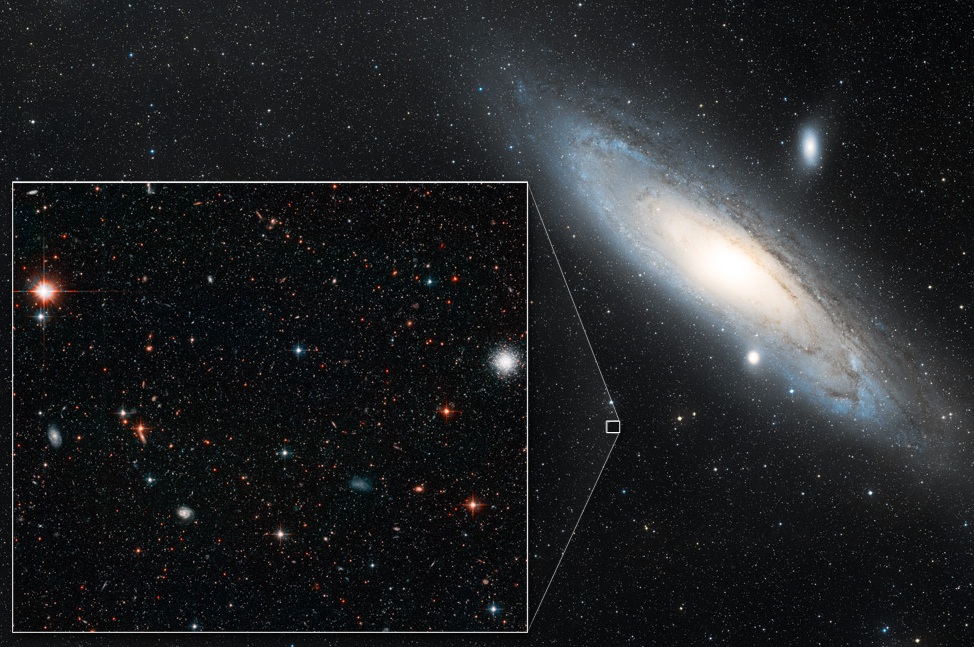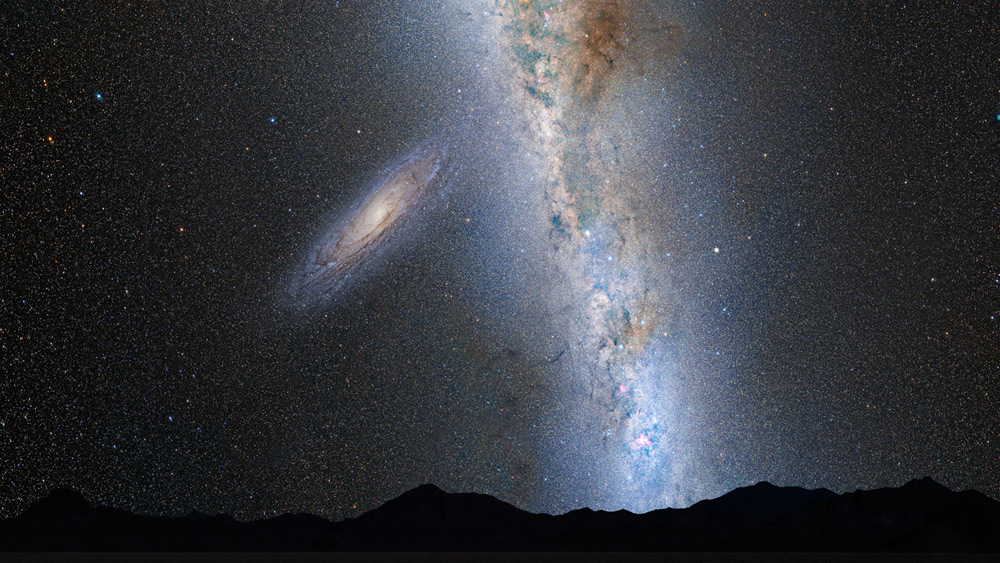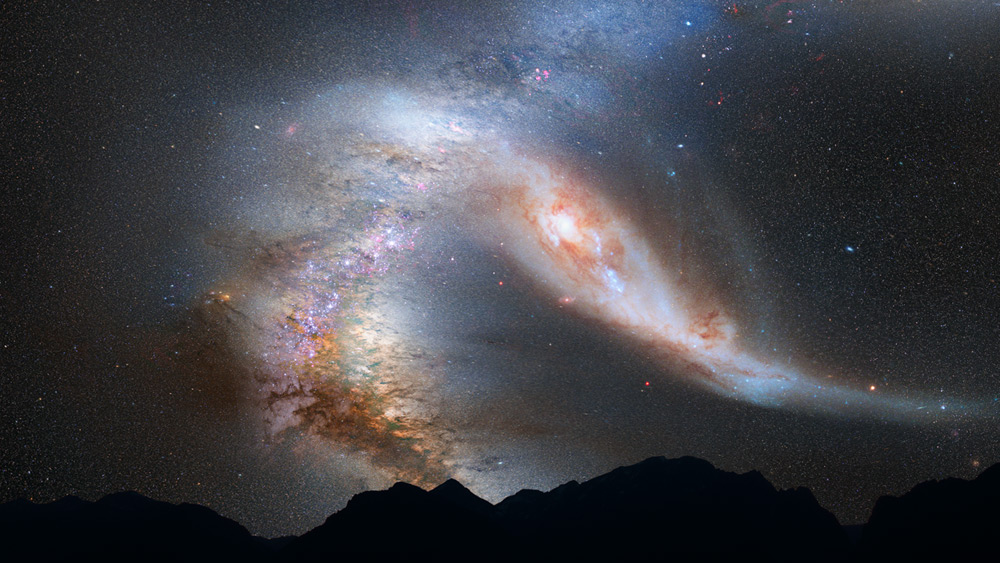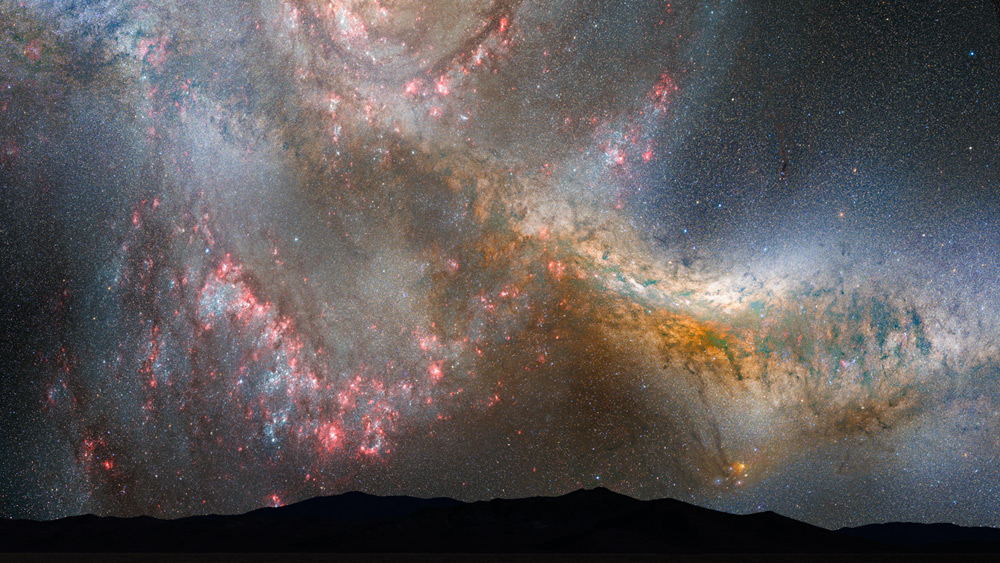Milky Way Galaxy's Head-On Crash with Andromeda (Gallery)
Andromeda Galaxy and the Milky Way Collision

This photo illustration depicts a view of the night sky just before the predicted merger between our Milky Way galaxy and the neighboring Andromeda galaxy. Image released May 31, 2012.
Halo of Andromeda Galaxy Used to Measure Its Drift Across Space

This composite image shows a region in the halo in the neighboring Andromeda galaxy that astronomers used to precisely measure the galaxy's sideways motion on the sky. Image released May 31, 2012.
Nighttime Sky View of Future Galaxy Merger: Present Day

This is a nighttime view of the current sky, with the bright belt of our Milky Way. The Andromeda galaxy lies 2.5 million light-years away and looks like a faint spindle, several times the diameter of the full Moon. Image released May 31, 2012.
Nighttime Sky View of Future Galaxy Merger: 2 Billion Years

The disk of the approaching Andromeda galaxy is noticeably larger. Image released May 31, 2012.
Nighttime Sky View of Future Galaxy Merger: 3.75 Billion Years

Andromeda fills the field of view. The Milky Way begins to show distortion due to tidal pull from Andromeda. Image released May 31, 2012.
Nighttime Sky View of Future Galaxy Merger: 4 Billion Years

After its first close pass, Andromeda is tidally stretched out. The Milky Way, too, becomes warped. Image released May 31, 2012.
Fate of Sun After Galaxy Collision

This illustration is a before-and-after comparison of the size of our Milky Way galaxy at present, and after it fully completes a merger with the neighboring Andromeda galaxy 10 billion years from now. The merged galaxies will blend together to create an elliptical galaxy of aging stars. Our Sun now orbits in the Milky Way's disk. But after the merger, it likely will be tossed into a looping orbit that will bring it both nearer to the center and farther into the outskirts of the newly formed elliptical galaxy. Image released May 31, 2012.
Breaking space news, the latest updates on rocket launches, skywatching events and more!
Nighttime Sky View of Future Galaxy Merger: 3.85-3.9 Billion Years

During the first close approach, the sky is ablaze with new star formation, which is evident in a plethora of emission nebulae and open young star clusters. Image released May 31, 2012.
Nighttime Sky View of Future Galaxy Merger: 3.85-3.9 Billion Years

During the first close approach, the sky is ablaze with new star formation, which is evident in a plethora of emission nebulae and open young star clusters. Image released May 31, 2012.
Nighttime Sky View of Future Galaxy Merger

This series of photo illustrations shows the predicted merger between our Milky Way galaxy and the neighboring Andromeda galaxy, as it will unfold over the next several billion years. The sequence is inspired by dynamical computer modeling of the inevitable future collision between the two galaxies. Image released May 31, 2012.
Nighttime Sky View of Future Galaxy Merger: 5.1 Billion Years

During the second close passage, the cores of the Milky Way and Andromeda appear as a pair of bright lobes. Star-forming nebulae are much less prominent because the interstellar gas and dust has been significantly decreased by previous bursts of star formation. Image released May 31, 2012.
Join our Space Forums to keep talking space on the latest missions, night sky and more! And if you have a news tip, correction or comment, let us know at: community@space.com.

Space.com is the premier source of space exploration, innovation and astronomy news, chronicling (and celebrating) humanity's ongoing expansion across the final frontier. Originally founded in 1999, Space.com is, and always has been, the passion of writers and editors who are space fans and also trained journalists. Our current news team consists of Editor-in-Chief Tariq Malik; Editor Hanneke Weitering, Senior Space Writer Mike Wall; Senior Writer Meghan Bartels; Senior Writer Chelsea Gohd, Senior Writer Tereza Pultarova and Staff Writer Alexander Cox, focusing on e-commerce. Senior Producer Steve Spaleta oversees our space videos, with Diana Whitcroft as our Social Media Editor.
